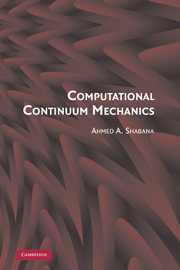7 - Finite Element Formulation: Small-Deformation, Large-Rotation Problem
Published online by Cambridge University Press: 06 July 2010
Summary
In the preceding chapter, a nonlinear finite element formulation for the large-deformation analysis was presented. This formulation, which is consistent with the motion description used in the theory of continuum mechanics and can be used to correctly describe an arbitrary rigid-body motion, leads to a constant mass matrix and nonlinear vector of elastic forces. The formulation imposes no restrictions on the amount of rotation or deformation within the element, except for the restriction imposed by the order of the interpolating polynomials used. In large-deformation problems, in general, the shape of deformation of the bodies can be complex and this, in turn, necessitates the use of a large number of finite element nodal coordinates in order to be able to correctly capture the geometry of deformation. Therefore, in the analysis of the large deformation problem using the absolute nodal coordinate formulation discussed in the preceding chapter, one simply selects an adequate number of finite elements and formulates the equations of motion in terms of the element nodal coordinates. There is no need to introduce another reference frame or be concerned with the use of coordinate reduction techniques. The results published in the literature on the absolute nodal coordinate formulation demonstrated that this formulation can be used in modeling very large deformations with relatively small number of finite elements compared to other existing nonlinear finite element formulations.
- Type
- Chapter
- Information
- Computational Continuum Mechanics , pp. 286 - 320Publisher: Cambridge University PressPrint publication year: 2008



